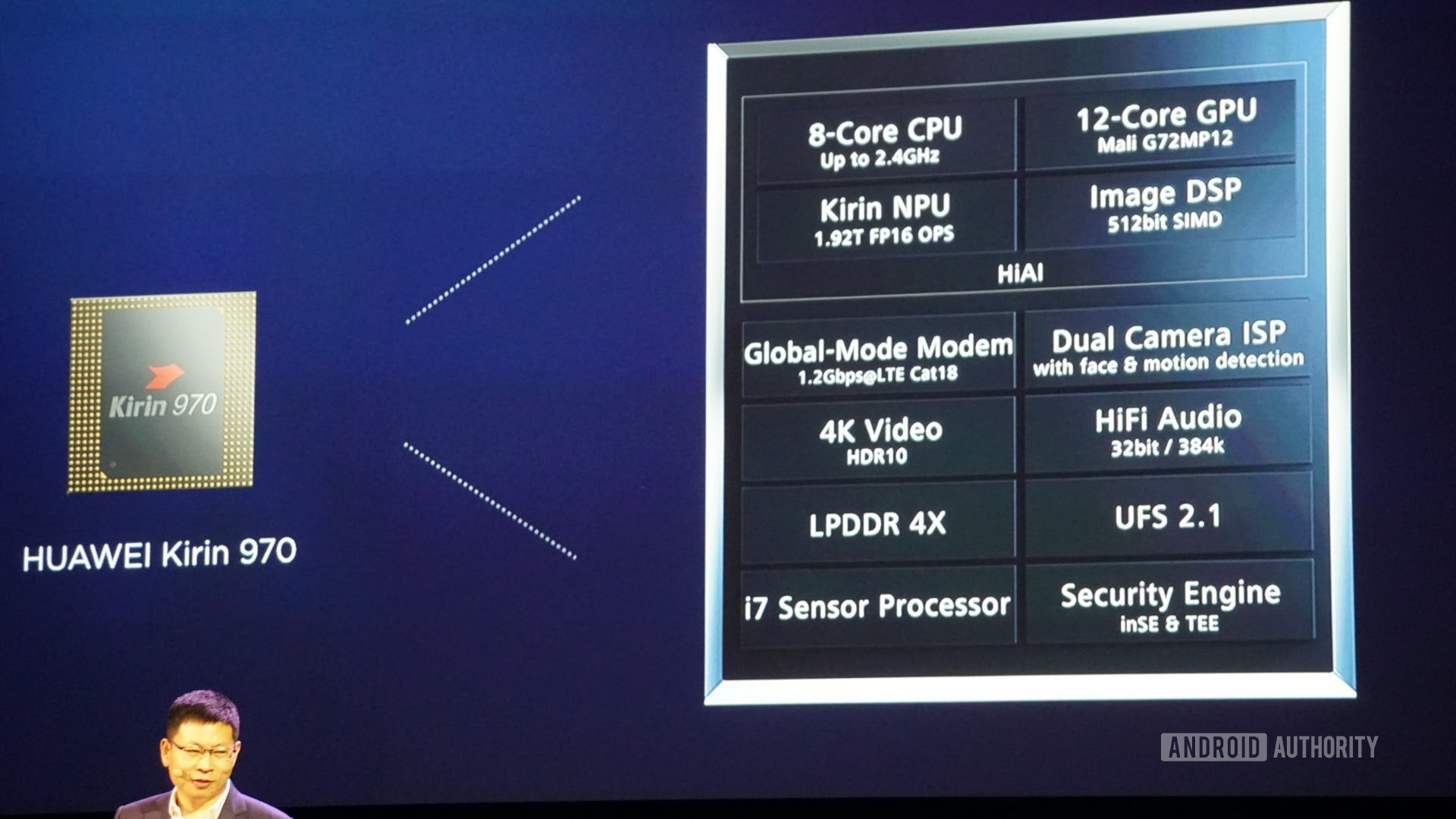Affiliate links on Android Authority may earn us a commission. Learn more.
SoC head-to-head: Snapdragon 845, Exynos 9810, and Kirin 970

2017 is coming to a close and three major SoC announcements from the big Android mobile chip vendors are rounding off the year. Qualcomm just unveiled its Snapdragon 845, Samsung recently gave away a few details about its next generation Exynos 9810, and HUAWEI’s HiSilicon Kirin 970 is already available in a few products.
Read Next: A guide to Samsung’s Exynos processors
We can’t compare these chips side by side yet, as we’re still waiting on 2018 flagship smartphones to even be announced, let alone arrive in our hands for testing. Samsung is also keeping some details about its latest hardware under wraps for now, so we’ll have to make a few educated guesses. Based on the details revealed so far we can see a divergence in approaches to dealing with the latest mobile trends, which might give the most tech savvy purchasers pause.
CPU designs diverge
The introduction of 64-bit processors years ago was a big change for Android, but it generated some homogeneity between CPU design, as SoC vendors opted for quick implementation of off-the-shelf Arm parts to speed up development. Fast forward to today and chip designers have had time to explore their own designs once more. The Arm licensing ecosystem has expanded with new options for licensees too.
Qualcomm has been making use of the “built on Arm Cortex technology” license for a couple of generations. The license offers numerous ways to customize an Arm CPU design, while allowing Qualcomm to market the design under the Kryo brand name. Samsung is now on its third generation fully-custom Mongoose core that only licenses the Arm architecture. In theory, this fully custom design should allow Samsung to push its chip in more extreme directions. It could attempt to chase Apple’s performance crown, but history suggests the company is more interested in subtle improvements to micro-architecture parts like branch prediction, task scheduling, and cache coherency. Meanwhile HiSilicon is sticking firmly with off the shelf components designed by Arm pretty much throughout its Kirin 970.
| Snapdragon 845 | Exynos 9810 | Kirin 970 | |
|---|---|---|---|
CPU | Snapdragon 845 4x Kryo 835 (Cortex-A75) @ 2.8 GHz 4x Kryo 835 (Cortex-A55) @ 1.7 GHz | Exynos 9810 4x Mongoose (3rd gen) 4x Cortex-A55 | Kirin 970 4x Cortex-A73 @ 2.4GHz 4x Cortex-A53 @ 1.8GHz |
AI core | Snapdragon 845 Hexagon 685 | Exynos 9810 VPU | Kirin 970 NPU |
GPU | Snapdragon 845 Adreno 630 | Exynos 9810 Mali-G72 MP18 | Kirin 970 Mali-G71 MP12 |
RAM | Snapdragon 845 LPDDR4x | Exynos 9810 LPDDR4x | Kirin 970 LPDDR4x |
Manufacturing | Snapdragon 845 10nm LPP FinFET | Exynos 9810 10nm LPP FinFET | Kirin 970 10nm FinFET |
In the past, this produced similar performance results, however the latest ARMv8.2 architecture revision and introduction of DynamIQ presents a major shift that will diversify performance. For example, moving big and LITTLE CPU cores into a single cluster should improve task sharing and energy efficiency, and new private L2 and shared L3 caches should further improve memory access and performance. The Cortex-A75 and A55 have also seen specific optimizations for popular machine learning instructions, although it’s possible a fully-custom design could improve this further. Qualcomm is quietly the first to hop onto the latest architecture revision, which puts it at an advantage, unless Samsung has made big strides with the 9810’s custom core and sub-system.
Huawei’s Kirin 970 uses last generation Cortex-A73 and A53 cores and the old two cluster design, so there are no special optimizations here. It’s certainly no slouch though, and this decision has allowed HiSilicon to invest development time into the second most notable difference between the three SoCs — their approach to machine learning and AI.

AI is the next-gen differentiator
HUAWEI was keen to point out the capabilities of its dedicated Neural Processing Unit (NPU) inside the Kirin 970 during launch, which has been specifically designed to accelerate machine learning applications. Qualcomm, on the other hand, has an integrated Hexagon DSP that it uses for audio, imaging, and machine learning tasks. However, both appear to have a heterogeneous compute approach to powering AI, with CPU, GPU, and DSP all having a role to play in delivering maximum performance versus power efficiency. Qualcomm appears to have taken this a step further with the 845 though. It now features a shared system cache in addition to a L3 cache for the CPU and regular system RAM, which can be accessed by a variety of components inside the platform. This could greatly improve the chip’s resource sharing capabilities for machine learning, and probably partially explains the 3x performance boost Qualcomm is claiming.

Unfortunately we don’t yet know if Samsung has made changes to the AI capabilities of new its latest Exynos 9810, but we imagine the company would have mentioned something during the reveal if it had made a major change. The last generation 8895 model based most of its machine learning capabilities on a Heterogeneous System Architecture with cache coherency between the CPU and GPU, using the company’s in-house Samsung Coherent Interconnect. This is very much Arm’s take on developing for machine learning too, avoiding the expense of dedicated hardware until common AI use cases become clear.
All three platforms support machine learning and key APIs, but their hardware implementations are slightly different.
Either way, this means future machine learning applications could run quite differently across all three of these flagship platforms. Not just in terms of performance, but also in terms of power consumed for a given tasks. Dedicated hardware and utilizing the latest ARMv8.2 architecture should give an edge here, at least in terms of power consumption. DSPs have been shown to consume a lot less power than CPUs or GPUs when performing certain tasks. Whether third party developers will optimize for Qualcomm, HUAWEI, and Arm Compute Library SDKs, or pick one over the others, could tip the performance scales. It’s worth noting that Kirin 970 and Snapdragon 845 support Tensorflow / Tensorflow Lite and Caffe / Caffe2, and the Exynos 9810 should have similar access through either Samsung’s own SDK or the Arm Compute Library. Ultimately this is still an area of hardware development where the best solution is yet to be decided.

The fastest data & best multimedia possible
There actually won’t be any divergence in 4G LTE speeds. All three of the chips feature integrated Category 18 LTE modems, boasting up to 1.2 Gbps down and 150 Mbps upload speeds on compatible networks. Importantly, these chips’ modems support global network compatibility, so we can see them in multiple regions.
The three have also made similarly big pushes to support high-end media. 4K UHD video capture and playback is available across these flagship chips, and all three companies packed in dedicated processing units to handle these increasingly demanding tasks efficiently. On the content creation side, dual camera support again appears across the board, opening up possibilities for wide angle, monochrome, or optical zoom capabilities. Support for HDR-10 and 4K video recording is common, although Samsung boasts up to 120 fps video recording at this resolution, Qualcomm has just moved on to 60 fps, and the Kirin 970 only offers 30 fps 4K encoding. All of these are still boons for high quality video enthusiasts though. Similarly, HUAWEI and Qualcomm have packed in a 32-bit 384 kHz capable DAC into their latest products for HiFi audio, but those numbers have little meaning on their own.
With 1.2 Gbps modems, dedicated security hardware, premium audio, and 4K HDR video support, the big three all have the major consumer trends covered.
There’s also a dedicated hardware security unit inside each chip. These are used to house fingerprint, facial scanning, and other personal bio-metric information, alongside cryptography keys for apps and OS level security that’s increasingly important these days. Especially as consumers continue to embrace online and mobile banking and payments using their smartphones.

Which will be the best?
Ultimately, these chips cater to similar trends. It’s not surprising to see so much crossover in terms of the building blocks and feature set. The days of Qualcomm holding the integrated modem advantage are gone. These chips all cover essentials like performance, connectivity, and multimedia pretty well. Qualcomm might be the first to adopt the latest advances in Arm’s CPU architecture, but we are seeing more meaningful divergence in the AI and machine learning spaces, with each vendor trying to find the best integrated solution to power this increasingly popular technology.
Because of this, raw performance benchmark tests are becoming increasingly irrelevant in today’s mobile SoC market. Chips cater to an increasingly broad range of uses and technologies. Picking the best processor based on a few scenarios misses the bigger picture. The best SoC enables device manufacturers to build products that cater to consumer demands, be that with the fastest smart assistant, best in class audio setup, or the handset with the longest battery life.
Given that HUAWEI and Samsung are using these chips for their own smartphone products, they’re going to benefit from the kind of very tight integration that Apple is regularly lauded for. Qualcomm has to cast a wider net to cater to all of is potential customer demands, and the Snapdragon 845 certainly goes above and beyond in this regard. But who knows if OEMs will utilize all these features. We will have to wait until we can go hands-on with products side-by-side to see what each brings to the table, but all three chips look highly capable. They will no-doubt power some impressive handsets over the next twelve months.